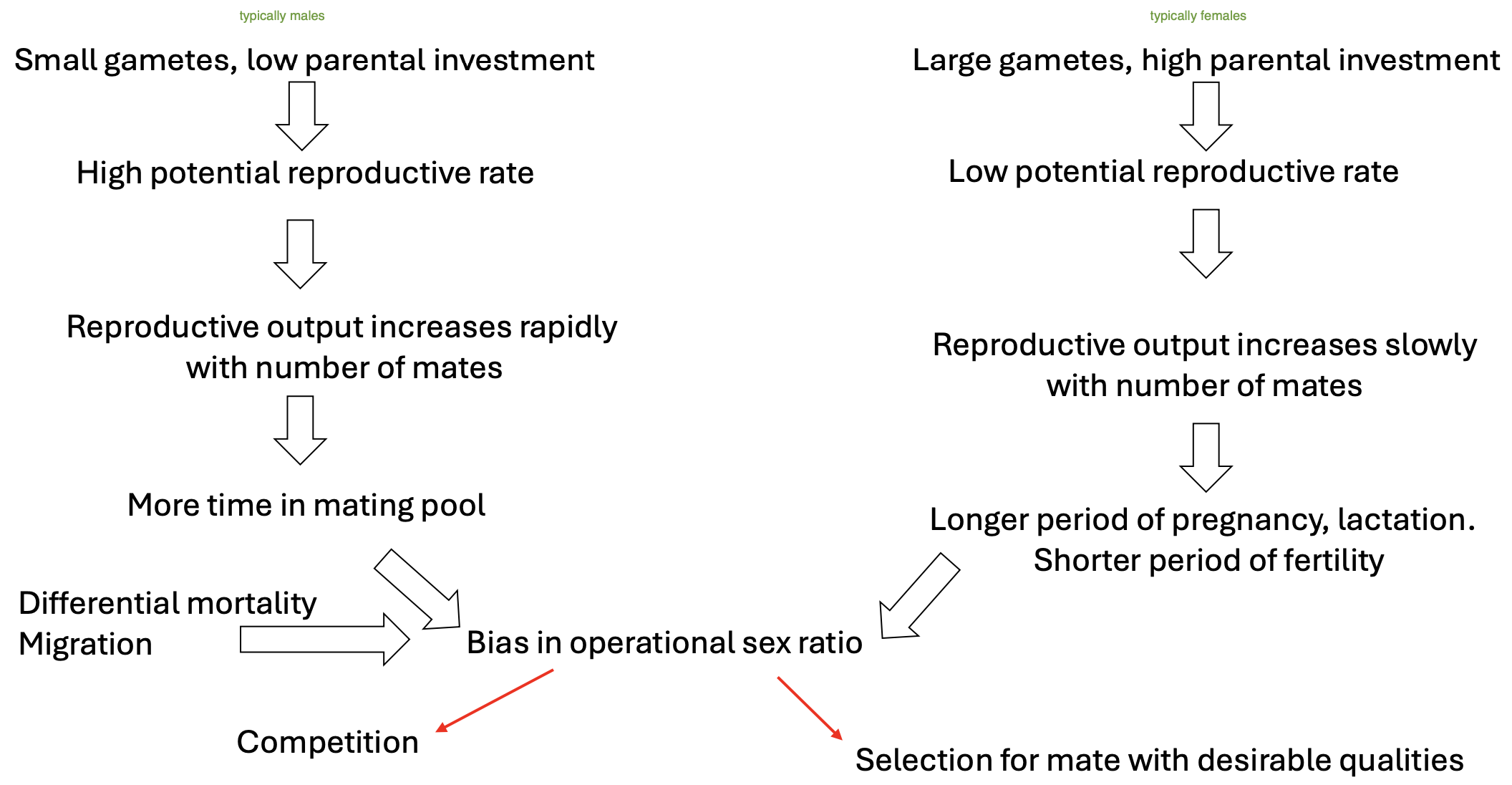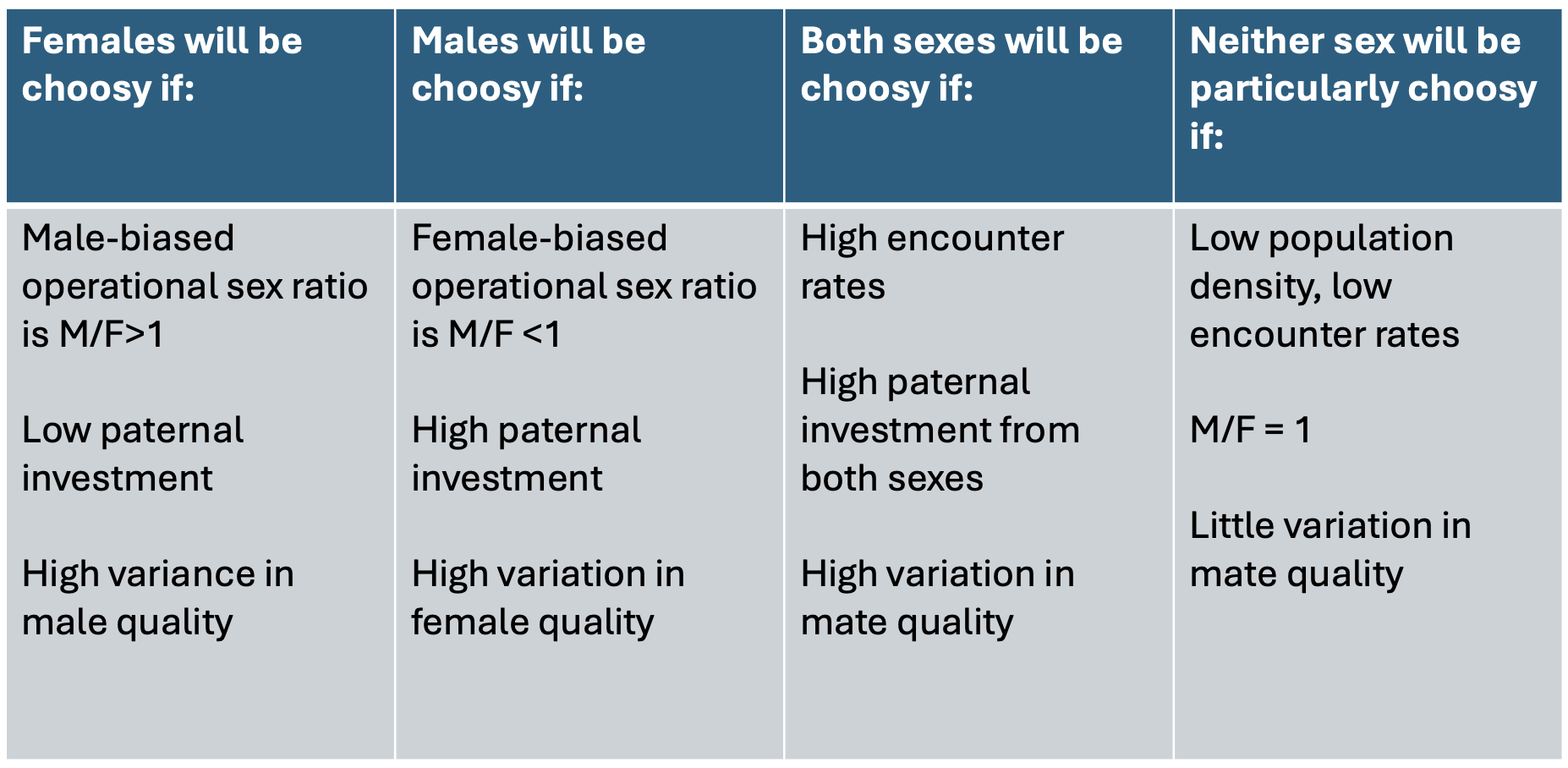Lesson 4 - Sexual Selection
1/29
There's no tags or description
Looks like no tags are added yet.
Name | Mastery | Learn | Test | Matching | Spaced |
|---|
No study sessions yet.
30 Terms
What is sexual reproduction and how does it work?
• Two parents
• Gametes (sperm, egg), single set of chromosomes
• Fertilization
• Zygote (diploid)
What does Darwin outline in Descent of man and selection in relation to sex?
• Sexual selection (reproduction), complements natural selection (survival)
• How to attract the opposite sex
• How to fight competition and access a mate
• What constitutes a "good" mate?
—> he was not aware of the genetic/cellular levels, so he was mainly looking at behavior for sexual selection
What is mating exclusivity?
The number of individuals with which an individual mates.
(one vs multiple)
What is pair bonding?
A social bond between individuals for breeding offspring.
(what happens when individuals raise offspring – not just biological production of offspring, but also social bond to raise them)
What is intra-sexual selection?
• Intra = within
• Competition between members of the same sex for access to a mate
Male-male competition
Female-female competition
—> In the animal kingdom mainly happens between males (but occasionally also females)
—>Fight
What are two examples of intra-sex selection?
Fighting: Elephant seals and deers (males) — only the winner can mate with the female (occurs before mating).
Sperm Competition = Occurs just before/during/after sexual reproduction
Damsel fly → male has particular hair on back of reproductive organ that is used to remove sperm from other males in the female’s reproductive tract.
What is inter-sexual selection?
• Inter = between
• Courtship, display by one sex
—> Competition/play between the sexes (more like a game, whereas intra-sexual is more of a fight)
What is an example of inter-sex selection?
• Courtship (mainly done by males, often they show off traits they possess or a behavioral display)
Eg. birds dancing for their mates
Member (mainly females) chooses their mate based on this courtship/play
What is the “choosy sex” and why is it important?
Member who chooses is referred to as the “choosy sex”
The last thing you want to do is pick the wrong mate, bc you don’t want offspring to be sick, it would be a waste of resources, you want to produce viable offspring that can survive
What are Angus Bateman's principles?
• Males experience a higher variance in reproductive success (number of offspring) than females
• Males have a higher variance in the number of mates than females
• Males have a higher correlation between number of mates and number of offspring than females
How did Bateman establish his principles?
He used fruit flys to try and better understand reproductive behaviors.
One part of the puzzle, remember these principles!
Realized experiences of males and females are very different.
Males experience a higher variance (some have many more, some have very few offspring).
The more matings a male has, the more offspring (hence a higher correlation).
Who came up with the Parental Investment Theory?
Robert Trivers
What is parental investment?
Any investment by the parent in an individual offspring that increases the offspring’s change of survival, at the cost of the parent’s ability to invest in other offspring
What is the Parental Investment Theory?
Ideal number of offspring differs for each parent
• Investment (energy, time, gestation, feeding, protection, care, etc...)
• Low-investment parent
• High-investment parent
—> Need to understand what degree/level each partner invests in reproduction
—> Investment of any resource the parent allocates to ensure the survival of their offspring - but this also comes with a trade off, bc you want as many offspring as possible and as many of those offspring to survive
What two theories create the parts of a puzzle?
Parental Investment Theory + Bateman’s Principles
What is the goal of reproduction?
You want as many offspring + descendants as possible, but also the energy/resources to ensure their survival
Different parents (males vs females) can have very different levels of investment
What categorizes low-investment parents?
→ reproductive strategy: increase number of matings/mates
→ drives forces of intra-sexual selection (want as many offspring as possible, but don’t give a lot of resources, time, energy, etc into offspring)
What categorizes high-investment parents?
→ reproductive strategy: choosy
→ drives forces of intersexual selection (picky with who they choose to mate with, if they spend a lot of time/energy to raise the offspring, they want to make sure that they mate with someone who has favorable genes to pass along and increase chance of survival)
How does the parental investment theory and Bateman’s principle help explain?
Some of the traits Darwin could not initally explain, can be explained through these dynamics, to attract females and display their qualities as good mates (like the peacock tail).
What is the operational sex ratio?
• Sex ratio = 1:1
• Operational sex ratio: fertilisable females / sexually active males
ie. how many females in the population are able to be fertilised at any given point in time, divded by all the males who are sexually active.
Explain the Darwin-Bateman-Parker-Trivers paradigm.
Males generally have greater reproductive success the more mates they have.
Males also generally spend more time in the mating pool (either mature earlier or ‘retire’ later than females).
Yet they also have a higher mortality and migration rate which has an impact on the operational sex ratio.

When will males or females be more choosy, and how does it affect the operational sex ratio and parental investment?

What is sexual dimorphism?
The distinct physical or behavioral differences between males and females of the same species, beyond their primary reproductive organs.
Who proposed runaway selection?
Fisher — one of the founders of the modern synthesis.
What is runaway selection?
• Initial preference leads to a character being preferred by many females
• Preference becomes self-reinforcing
In the case of peacocks:
• Mating with males with long tails produces sons with long tails (“sexy sons”), and daughter with a preference for long tails
• Female choice drives selection for longer tails (until costs impose trade-off)
What is the ‘good-genes’ view?
• Certain attributes signal mate quality
• These attributes can be used to assess mate for “good genes” (mate potential)
—> improves chance of offspring survival
What are ‘honest signals’?
• Truly linked to quality of the trait advertised
• good signals, in order to be reliable/honest, they cannot be faked
—> the long tail of a peacock is a genuine sign of good genes. There must be a direct and true link between a trait and the underlying qualities of a good mate.
• Handicap principle
• Index signals
What is the handicap principle (Amotz Zahavi)?
Traits impose a significant cost on the signaller. Only high-quality individuals can afford the high- cost trait (handicap)
—> there must be some kind of cost (handicap) so that only very high quality mate can bear the cost of carrying such a fancy attribute.
What are ‘index signals’?
Cannot be faked (e.g., physically constrained)
Under which evolutionary conditions would sexual dimorphism be less pronounced?
Eg penguins, swans —> males and females are very similar.
In species where both male and female are high commitment?
In a mating system where there is a more monogamous relationship, mates don’t have to compete as much